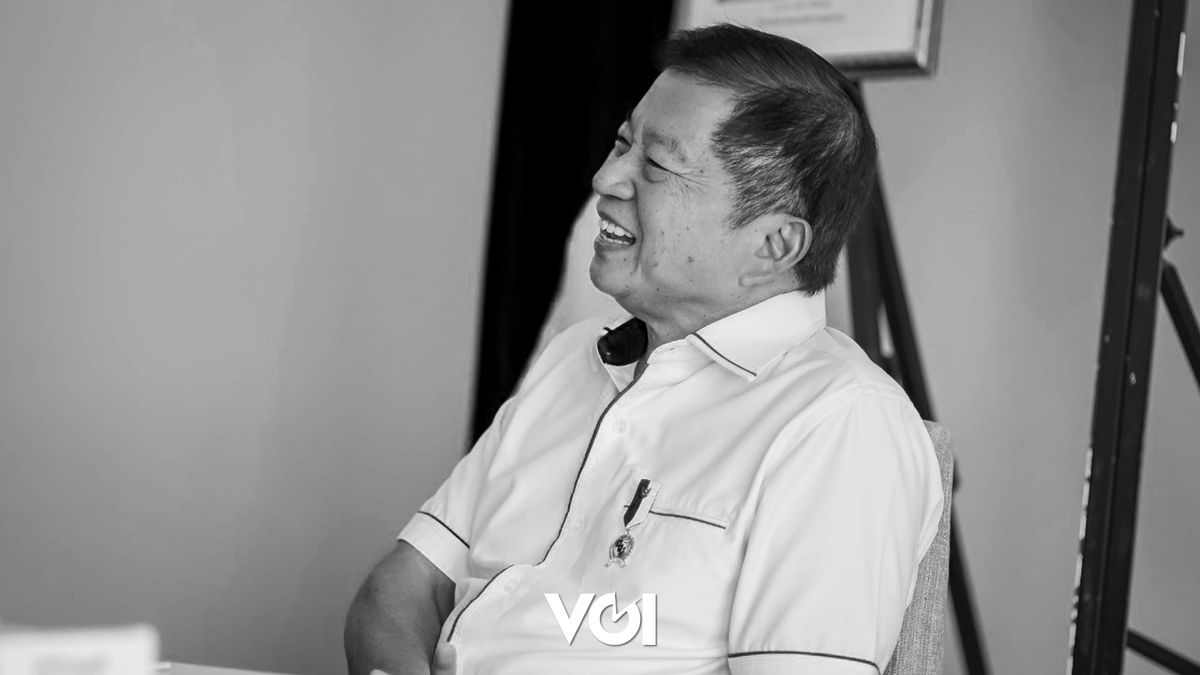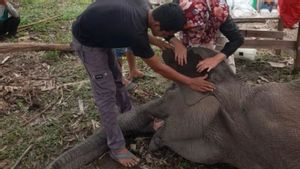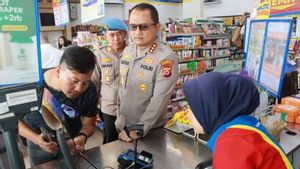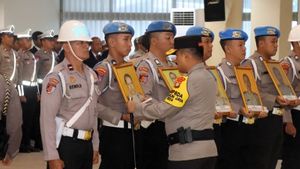Indonesia's economic growth before the corona pandemic was very promising. It is not surprising that the Head of Bappenas and the Minister of National Development Planning in the Advanced Indonesia Cabinet, Dr. Ir. H. Suharso Monoarfa projects that by 2045, Indonesia will become a developed country. But suddenly an uninvited guest came, the COVID-19 pandemic occurred and paralyzed almost all lines of life, all the projections were corrected instantly. But according to Suharso there is still hope to achieve that projection. What are the conditions for advancing Indonesia? He shared his ideas with the VOI team.
***
The global COVID-19 pandemic has brought many countries down. Development plans based on economic growth before the pandemic took place changed completely. Likewise with Indonesia's development projections that have been projected by the Ministry of National Development Planning of the Republic of Indonesia/National Development Planning Agency (Bappenas).
In 2015 Indonesia's economic growth showed an encouraging trend. It is not surprising that the Head of Bappenas, Dr. Ir. H. Suharso Monoarfa used the 2015 economic growth rate (by 5.7 percent) as a benchmark. Based on this figure, in 2045 or coinciding with 100 years of independence, it is projected that Indonesia will become a developed country.
However, everything was corrected when the corona pandemic hit almost all countries in the world, including Indonesia, which began to be felt in March 2020. According to Monoarfa, the projection of Indonesia to become a developed country faces no light challenges. The question is whether this projection can still be realized? In fact, according to the man who was born in Mataram (NTB) on October 31, 1954, this projection can still be realized. But there are conditions that must be met.
"When we recalculate, our desire for Indonesia to become a developed country can still be achieved, as long as our economic growth is at 7 percent per year on a basis in 2021. But if economic growth is below that, it will take longer to achieve the goal. So if our economic growth is at 5 percent, it's still normal. If the economic growth is 6 percent, thank God, it's a bit of relief. Now, if 7 percent will return to the original projector, Indonesia will become a developed country in 2045," he said.
To achieve this projection, Bappenas has rolled out six strategies. These six strategies support each other, ranging from strategies to increase human resources, economic productivity, green economy, digital transformation, integration of the domestic economy and relocation of the nation's capital.
In addition, Monoarfa also compared Indonesia's economic growth with several countries such as China, Vietnam and the Philippines. He also answered questions about foreign investment in Indonesia and various other questions from Iqbal Irsyad and Edy Suherli and from VOI. Interviews were conducted virtually recently. Here is the full excerpt.

What are the projections for Indonesia's economic growth after 100 years of independence?
Every country has guidelines. Where is our guide after 100 years of Indonesia's independence? And on the momentum of 100 years of Indonesia's independence, what do we want to achieve? The age of 100 years for Indonesia's independence means the year 2045. We try to calculate based on numbers in 2015, we take the trajectory with an average growth rate of 5.7 percent and in certain segments it can reach 6.2 percent. Until 2025, 2030, 2035 our economic growth rate is (expected) to continue to be high, it is estimated that in 2045 our real GDP (gross domestic income) is around 5.7 percent and GDP per capita is 5 percent. If we look at this number, our GDP in 2045 will reach approximately 7 trillion US Dollars in total.
At that time, if we divide by the total population of Indonesia, the income per capita is 23,100 US Dollars. This means that Indonesia has become an economically developed country.
We also have homework, how can we graduate from the Middle Income Trap (MIT) country, which is a middle-income country that is in a trap that we cannot escape. In this calculation, last year we have penetrated the 4000's US Dollars, meaning that Indonesia has passed the Lower Middle Income Country. There are two middle incomes; lower and upper middle income.
The level of income per capita of the world's average population in a country is calculated; low income, middle income (lower middle income and upper middle income) and high economy countries. In our calculations, actually in 2020 we have reached the upper middle income country.
When the corona pandemic hits, is there a target correction?
When the corona pandemic hit Indonesia, the numbers above were immediately corrected. We have to recalculate. When we recalculate, our desire for Indonesia to become a developed country can still be achieved, as long as our economic growth is at 7 percent per year on a basis in 2021. But if economic growth is below that, it will take longer to achieve the goal. So if the growth is 5 percent, it's normal. If the economic growth is 6 percent, thank God. Now, if 7 percent will return to the original projector, Indonesia will become a developed country in 2045.
When compared to other countries, such as Vietnam, what is the condition of Indonesia?
When compared to Vietnam, assuming 2019-2020. From the data we have, in 2035 Indonesia will be left behind by Vietnam.

What are the strategies carried out by the government?
We have developed six grand strategies for transforming the Indonesian economy towards inclusive and sustainable development. The first strategy of competitive HR. Namely, health issues that have been tested during this pandemic, then education and research and innovation. The second strategy is the productivity of the economic sector, in this case the productivity in the industrialization sector, the productivity of MSMEs and the modernization of agriculture which includes livestock and fishermen.
Then the third strategy is a green economy. This is very important, we choose a low-carbon economy and a circular economy, as well as a blue economy and energy transition. All this to achieve net zero emission. Then the fourth strategy of digital transformation which includes digital infrastructure, digital utilization and strengthening of enablers.
The fifth is the integration of the domestic economy, which includes connectivity infrastructure; Super Hub, Sea Hub and Air Hub. A strong domestic value chain will be the capital to compete at the global level. And the sixth is the strategy of moving the national capital. It will become a center for new economic growth and a place to practice green economy, digital transformation and there where highly competitive human resources take part.
It is hoped that in 2045 the center for excellence in the fields of science and technology can reach 190/190. Then the percentage that holds a Ph.D. can reach 70 percent, now it's only 13 percent. And technology-based companies could increase to 1,000. Then we can achieve advanced pilot research.
Regarding agriculture, land is decreasing and people's interest in becoming farmers is also not high, even though this is included in the field that is included in the strategy, what is it like to deal with this condition?
There are still those who think that being a farmer is inferior. What is needed is to increase competitiveness and capabilities. This aims to increase their exchange rate. Currently, the exchange rate has only increased by 4 to 5 percent of production. The exchange rate of our farmers is only 104 or 105. So there is a very thin line between the acquisition value and the need, it just fits. So if we learn from other countries such as China and Thailand, they can reach 120, 130 and even 140. Why can't Indonesia do that because the production costs are expensive. Agriculture must be promising. And I see that young children have started to have an interest in the field of organic farming. They provide seeds, fertilizers to farmers and they buy the produce directly. This makes farmers happy.
Another effort is to prevent farm laborers from migrating to the city after the harvest season. The trick is to involve them in the agricultural production sector. Again, the increase in the farmer's exchange rate earlier. If we can increase the exchange rate of farmers, both sides can be achieved at the same time; increase agricultural productivity and reduce poverty.
What about the strategy in the health sector, while the pandemic is still not over?
With this pandemic we are all shocked. It turns out that our health system is still very vulnerable during the pandemic. There are many problems in this health issue. The example of our TB problem is number three in the world. We want to reduce the incidence of TB cases from 314 to 231 per 100,000 population. Another example is about malaria. We want to eliminate malaria, now we only want to increase 300 districts/cities to 355 and reach all districts/cities in Indonesia. Then regarding leprosy, we are back again in third place. Whereas in the 1980s we were declared free.
Regarding our baby's immunization, it's only 57 percent, it should be 100 percent. Children who do not receive complete basic immunization are more susceptible to stunting (a chronic malnutrition problem caused by a lack of nutritional intake for a long time, resulting in growth disorders in children, namely the child's height is lower or shorter than the standard age). In 2024 we expect the stunting rate to be 14 percent. The maternal mortality rate is 205/100,000 live births.
We hope that the national referral hospital will increase to 40 in 2024, now there are only 14 hospitals. Currently, there are 12 percent of health centers without a doctor in all of Indonesia. We hope next year it will be 0 percent. Hospitals that have 4 basic specialists (Internal Medicine, Surgery, Pediatrics, Obstetrics and Gynecology) and 3 other specialists (Anesthesia, Pathology and Radiology) are only 12 percent. In 2022 we ask for an increase of 80 percent. Because in 2024 it could be 100 percent. The first level of health facilities is only 40 percent, it should be 80 percent. This effort is being made to achieve universal healthcare related to life expectancy.
Regarding foreign investment in development, how does Bappenas see it?
If we compare with China, the level of FDI (foreign direct investment) is high, growing 47.8 percent in 2021. And FDI comes from ASEAN countries, the Belt Road Initiative and the European Union. Why do they do that because the number of COVID-19 is flat, meaning that it can be overcome. And they take advantage of all the bilateral agreements and avoid double taxation. In addition to FDI, investors from within China are also encouraged. So we need to open up foreign investment to Indonesia and encourage it as well. But those related to the circular economy, blue economy and green economy as well as economic downstreaming in order to improve our manufacturing industry. I think for the sector it's okay.
What about the market place, where the goods are from China?
Regarding this market place, the MSMEs are resellers, not producers. It should be supported by MSMEs that produce goods or services.
The formula in China to grow the economy after the pandemic is very good, how to apply it to Indonesia?
In China the president takes the lead on his own to solve the problems they face. In Indonesia, this is actually the case, only in the provinces and districts/cities sometimes the priorities are not the same. They still prioritize physical development, because it is visible. Such as building roads, monuments, squares. Then there is the regent's or governor's house which is cool, even though the area is poor, this is strange. Bappenas encourages regional heads on how they can overcome poverty and increase the exchange rate of farmers, fishermen and others in the preparation of development in their regions.
Caring for Unity with Development

As a politician, the role and role of Suharso Monoarfa cannot be doubted. Under the auspices of the United Development Party (PPP), he has already started his career as a politician from ordinary members and is now in charge of the Kaaba symbol.
He finished elementary to high school in the city of Malang. Then he continued his studies in Bandung at the Bandung Academy of Geology and Mining (1973). Then he moved to the Department of Planning, Faculty of Civil Engineering and Planning, Bandung Institute of Technology (1974-1978). After working in several institutions he continued his studies at EDP University of Michigan (1994).
He has held various important positions in a number of companies. Among them, Suharso was Director of PT Bukaka Sembawang Systems (1995–1998) and Director of PT Bukaka Telekomindo International (1997–2000). And he also served as President Commissioner of PT Agro Utama Global (1999-2002).
From the business world and he penetrated political parties. This Gorontalo noble blooded man was a member of the Indonesian House of Representatives for the 2004-2009 period from the PPP for the Gorontalo constituency. And in the next period he was again trusted by his constituents to become the people's representative for the 2009-2014 period.

However, he accepted the offer to become State Minister for Public Housing in the United Indonesia Cabinet II (2009-2011). On the way, he resigned due to personal reasons on October 17, 2011. In 2015-2019, Suharso was trusted to become a member of the Presidential Advisory Council (Wantimpres).
The situation was urgent after PPP chairman Romahurmuziy was named a KPK suspect. Through the PPP Daily Management Meeting which was attended by the Sharia Council, Advisory Council, Expert Council and Party Court, Suharso was appointed as Plt. (Task Implementation) General Chairperson of the PPP DPP on March 16, 2019.
He was elected by acclamation as the General Chair of the PPP DPP at the PPP IX Congress in Makassar on December 19, 2020. The problem was that no one dared to run as a candidate for General Chair other than himself at that time.
The leadership style of this father of three - Andhika Mohammad Yudhistira Monoarfa, Raushanfikri Enaldo Monoarfa, and Ainy Syahputri Monoarfa, is indeed different from the leadership style of other figures and heads of political parties who often highlight personal figures.
On the other hand, in the PPP leadership he was more focused on the work program. "We focus on electoral work. And the electoral work ensures to the public that PPP can still be accepted and can answer the problems faced by the community," he said.

For that reason, it is very rare for billboards or other forms of party promotions to display this photo of the PPP General Chair. Compare with other parties where there is a billboard there is a photo of the party chairman. Monoarfa presupposes something like this with a fantastic work. "There is no fantastic work, I don't post my photo anywhere, only the party logo," he said.
After being elected as the General Chair of the PPP DPP, he indeed carried the tagline 'Maintaining Unity with Development. “We introduced the tagline of maintaining unity with development. Hungry people can't be brought together, how can people who don't have jobs be invited to unite If the stomach and work are finished, then people can be invited to hang out. As with caring for culture with tourism, don't reverse it," he said.
What are your targets for the 2024 election? When asked a question like this, he answered firmly. "I want to return the PPP votes that were 'borrowed' by other parties, as we have achieved in 2004," said Suharso Monoarfa optimistically.
***
"When the corona pandemic hit Indonesia, the number above the projected economic growth) was immediately corrected. We have to recalculate. When we recalculate, our desire for Indonesia to become a developed country can still be achieved, as long as our economic growth is at 7 percent per year on a basis in 2021."
Suharso Monoarfa
***
The English, Chinese, Japanese, Arabic, and French versions are automatically generated by the AI. So there may still be inaccuracies in translating, please always see Indonesian as our main language. (system supported by DigitalSiber.id)













